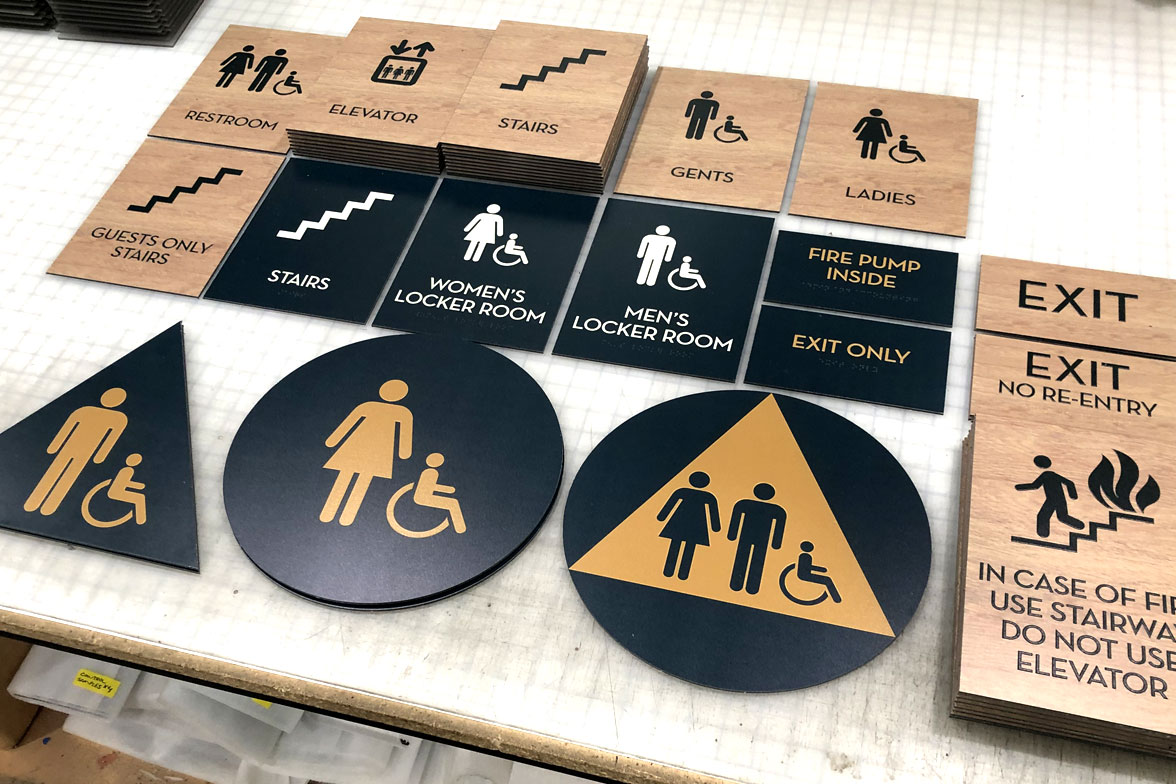ADA Signs: Essential Tools for Inclusive Environments
ADA Signs: Essential Tools for Inclusive Environments
Blog Article
ADA Signage: Making Certain Ease Of Access and Conformity in Public Spaces
ADA signage plays an indispensable duty in guaranteeing ease of access and conformity within public spaces, considerably contributing to an inclusive setting for people with impairments. By adhering to ADA standards, signage not only assists in navigating but likewise highlights a company's devotion to diversity and equal rights. As we explore the subtleties of ADA signs, from responsive attributes to make intricacies, it's important to think about exactly how these elements coalesce to support the civil liberties of all users. What are the usual risks companies encounter in preserving compliance, and how can future patterns in signage continue to drive availability forward?
Importance of ADA Signs
In modern culture, the significance of ADA signage prolongs beyond plain conformity with legal mandates to symbolize a commitment to inclusivity and availability for all people. These signs are important in producing atmospheres where individuals with specials needs can browse public rooms with the same simplicity and freedom as those without handicaps. By supplying standard and clear details, ADA signs makes sure that everybody can access facilities, services, and information without barriers.
The relevance of ADA signage exists in its capability to improve the top quality of life for people with handicaps by promoting equivalent access. It eliminates the obstacles that might or else hinder their capability to get involved completely in community life. Moreover, these signs work as visible signs of a company's dedication to diversity and equality, mirroring wider societal values that promote the civil liberties and dignity of all individuals.
In addition, ADA signs plays a critical duty in public safety. By directing people to departures, restrooms, and other important facilities, it guarantees that all individuals, despite physical capability, can evacuate safely throughout emergencies. In summary, ADA signs is not simply a governing demand however an effective tool for cultivating a fair and comprehensive society.
Crucial Element of Compliance

Placement is important; signs need to be set up in areas that are conveniently noticeable and obtainable. Usually, signage should be mounted in between 48 and 60 inches from the ground to make certain access for both standing and mobility device individuals. Responsive aspects, such as Braille, are vital for individuals with visual problems, offering vital info in a non-visual format.
High-contrast shades in between the text and history are needed to improve readability for individuals with low vision. The ADA mandates details comparison ratios to make certain clearness. Furthermore, character dimension is an essential factor to consider, with minimal elevation needs determined by the checking out distance to ensure readability from numerous angles.
Style Factors To Consider for Ease Of Access
Creating available signs needs a meticulous strategy to ensure it fulfills the demands of all users, specifically those with specials needs. This involves taking into consideration various layout aspects that enhance readability and functionality. Trick aspects consist of the option of typeface, color comparison, and tactile functions. Typefaces ought to be sans-serif, with clear and straightforward letterforms, to promote easy analysis. recommended you read The dimension of the text is similarly crucial, with ADA standards advising a minimum height based upon checking out distance to guarantee readability.
Contrasting colors between message and history are essential for exposure, particularly for individuals with visual impairments. Additionally, responsive elements, such as Braille and increased personalities, are crucial for individuals that are blind or have reduced vision.
In addition, the positioning of signs plays a considerable role in accessibility. Indicators ought to be mounted in areas that are unblocked and conveniently obtainable. Guaranteeing that signage is placed at proper heights and angles makes it possible for all individuals, including those utilizing wheelchairs, to interact with them effectively.
Usual Mistakes to Prevent

Another prevalent error is the incorrect positioning of signage. ADA standards define exact elevation and area needs to ensure that indications are easily visible and obtainable by all people, consisting of those utilizing mobility devices. Disregarding these standards not just interferes with access yet likewise takes the chance of non-compliance with legal criteria.
In addition, inadequate contrast in between text and history is a constant oversight. Sufficient comparison is crucial for readability, specifically for people with reduced vision. Developers in some cases select shades that are aesthetically attractive however do not have the needed comparison, providing the message hard to discern.
Finally, some designers fail to include tactile aspects, such as Braille, which are essential for people who are blind. Omitting these attributes not only leads to non-compliance with ADA laws yet also limits access for a segment of the populace that depends on responsive information.
Future Trends in Signs
Developments in innovation and increasing understanding of inclusivity are forming the future fads in signs style. As culture comes to be a lot more mindful of diverse demands, the integration of smart technologies right into signage is getting traction. Digital signage, for example, is progressing to include interactive features and real-time updates, which can be critical in supplying vibrant information in public areas. These indications commonly integrate touch screens or gesture-based controls, enabling individuals to navigate content customized to their specific requirements.
Another arising trend is the utilization of enhanced reality (AR) to enhance user experience. AR-enabled signage can overlay electronic details onto the physical atmosphere, giving aesthetically impaired people with auditory or haptic feedback. ADA Signs. This technology not only enhances ease of access yet also develops an engaging experience for all users
Sustainability is likewise a considerable factor influencing signage patterns. Environmentally friendly products and energy-efficient lighting solutions are being prioritized to straighten with worldwide ecological goals. Furthermore, advancements in materials scientific research great site are resulting in the advancement of more weather-resistant and durable signs.
Final Thought
ADA signage plays a vital role in ensuring availability and conformity within public areas by including tactile elements, high-contrast shades, and tactical positioning. The adherence to ADA requirements not only promotes risk-free navigation for individuals with specials needs but likewise represents an organization's dedication to diversity and inclusivity. By preventing usual mistakes and accepting future trends, public spaces can remain to advance these worths, making sure that the rights and dignity of all individuals are valued and supported.
ADA signage plays a vital role in guaranteeing accessibility and compliance within public spaces, substantially contributing to a comprehensive atmosphere for individuals with specials needs. As we discover the nuances of ADA signage, from responsive features to develop intricacies, it's vital to consider just how these elements coalesce to promote the rights of all users.In modern-day culture, the significance of ADA signage extends past plain conformity with lawful requireds to embody a commitment to inclusivity and availability for all people. By offering standardized and clear details, ADA signs guarantees that everyone can access centers, solutions, and details without obstacles.
ADA signs plays a vital function in assuring accessibility and compliance within public spaces by including tactile aspects, high-contrast shades, and strategic positioning. (ADA Signs)
Report this page